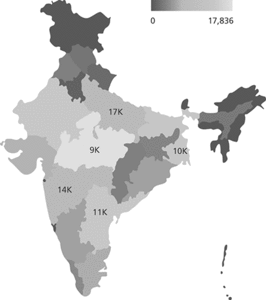The movement of a person or other animal from one region to another in search of food, breeding sites, or other resources or opportunities. Movement out of an area is emigration and movement into an area is immigration. Animal migration involves periodic, usually seasonal movements along well-defined routes, triggered by changing day length, the beginning or end of a rainy season, or some other periodic factor.
1. The movement of a group, atom, or double bond from one part of a molecule to another.
2. The movement of ions under the influence of an electric field.
The seasonal movement of complete populations of animals to a more favourable environment. It is usually a response to lower temperatures resulting in a reduced food supply, and is often triggered by a change in day length (see photoperiodism). Migration is common in mammals (e.g. porpoises and whales), fish (e.g. eels and salmon), and some insects (e.g. butterflies) but is most marked in birds. The Arctic tern, for example, migrates annually from its breeding ground in the Arctic circle to the Antarctic—a distance of some 17 600 km. Migrating animals possess considerable powers of orientation; birds seem to possess a compass sense, using the sun, pole stars (at night), and (in cloud) the earth’s magnetic lines of force as reference points (see navigation).
A method of reconstructing a seismic section so that dipping reflection events are repositioned to lie beneath their true surface locations and at corrected vertical two-way travel times. There are several migration methods. These include, for example, wave-equation, dip-moveout, ray-trace, finite-difference, wavefront-common-envelope, diffraction, and frequency-domain.
The movement of people from one place to another. The terms in-migration and out-migration are used for internal migration; voluntary migration refers to unforced movements, compulsory migration describes the expulsion of minorities from their country of birth by governments, or by warring factions. In the case of commuting, migration is a daily act, but, because there is no change of residence, a purist would not call commuting a migration, preferring the term mobility. Bell and Muhidin (2009) UNDP, Hum. Devt Repts. Res. Paper 2009/30, claim that ‘internal migration is the most significant process driving changes in the pattern of human settlement across much of the world’ and compare internal migration between countries.
In innovative migration people move to achieve something new (see Waxman in D. Mittelberg 1999). Economic migration is the movement of people from a poor to a richer area; Gerber (2006) Int. Mig. Rev. 40, 3 argues that market conditions are key determinants of contemporary migration patterns within Russia, for example. Boswell (2003) Int. Affs. 79, 3 finds that, in the EU, domestic political-electoral pressures and the institutional context have damaged longer-term strategies of migration management, refugee protection, and relations with third countries. The distinction between economic and betterment migration is unclear. Hoey (2005) J. Contemp. Ethnog. 34, 5 writes on non-economic migration. Findlay and Li (1997) Area 29, 1 see the migration act as a manifestation of an individual’s identity.
Some political geographers, such as J. Hyndman (2005) refer to migration wars—conflicts, usually by nation-states—over who to let in and who to keep out. As globalization proceeds, countries have invested heavily in border enforcement, increasing patrols along borders, building fences, and using infrared technology to keep people from crossing borders illegally. Mitra and Murayama, Inst. Developing Econs Res. Paper #137, provide a wealth of detail on the inter-state migration for India. Collins and Huang (2012) Area 44, 3, 270 present a useful review on the relative value of different research methods, and the challenges of designing, executing, and analysing different methodological approaches in migration research.

India—the number of migrants by state
Movement of people between regions or countries. Immigration and emigration are usually reserved for migration into and out of countries, respectively. Migration may be temporary, with the intention of returning to the country of origin in the future, or permanent; or migrants may not have decided between these alternatives at the time of migration. Migration is affected by push and pull factors. Push factors include lack of employment opportunities, and fears of disorder or of persecution on grounds of race, religion, or politics in the areas people leave. Pull factors include favourable employment opportunities, good health and educational facilities, public order and freedom, and a favourable climate, particularly for retirement, in the areas people move to.
- crater counting
- crater density studies
- Cratered Plains
- Cratered units
- crateriform
- crater lake
- Crates of Thebes (c.365–285)
- craton
- Cratylus (5th)
- crawler
- crawler-transporter
- crawling peg exchange rates
- Cray Inc.
- Crazy Horse (1849–77)
- CRC
- C-reactive protein
- cream of tartar
- creatine
- creatinine
- creatio ex nihilo
- creation
- creationism
- creationist
- creative accounting
- creative cluster